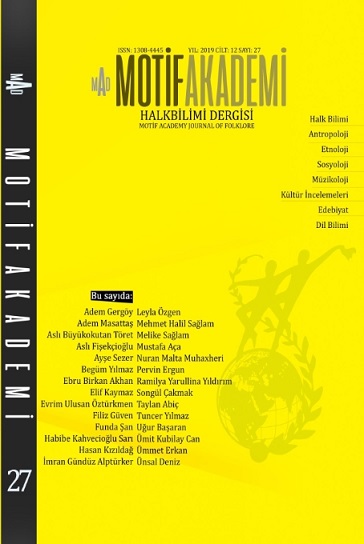HATAY’DA DİNÎ-ETNİK ÇEŞİTLİLİK VE BU ÇEŞİTLİLİĞİN DİLE YANSIMALARI
RELIGIOUS-ETHNIC DIVERSITY IN HATAY AND THE LANGUAGE REFLECTION OF THIS DIVERSITY
Author(s): Funda ŞanSubject(s): Customs / Folklore, Lexis, Sociolinguistics, Cultural Anthropology / Ethnology, Social differentiation, Philology
Published by: Motif Halk Oyunları Eğitim ve Öğretim Vakfı
Keywords: Bilingualism; lexical borrowing; Hatay; dialects; religious diversity; ethnic diversity;
Summary/Abstract: Hatay has been home to many different communities for centuries. For this reason, it is a colorful city with different ethnic origins, religions, beliefs and languages. In Hatay, customs, beliefs and traditions which belongs to different communities, have got mixed in time and influenced each other. In this multicultural city, there is no pure custom or traditions which is unaffected by other religions and languages. One of these effects occured in language use. Arabic and Turkish, which have been used together in the region for many years, have taken many things from each other. Transition between individuals who use both languages at the same time in their daily lives have revealed different oral characteristics. Previous studies about this subject have remained at theorical level, focusing mainly on language confusion created by bilingualism. Although this language confusion which mostly dealt with at syntactical level provides crucial information, this is insufficient to explain The Arabic and Turkish dialects in Hatay. Thus, in this study, the language confusion, which is mentioned at syntactical level at previous study, is discussed in detail for the first time in phonological, morphological and lexical levels. Our findings have been obtained through observing the daily dialogues of the source persons. In the article, which emerged as a result of the examination made by using oral sources, the religios and ethnic diversity in Hatay is mentioned briefly and the effects of Arabic and Turkish languages on each other through bilingual individuals are mentioned with examples.
Journal: Motif Akademi Halkbilimi Dergisi
- Issue Year: 12/2019
- Issue No: 27
- Page Range: 704-715
- Page Count: 12
- Language: Turkish

